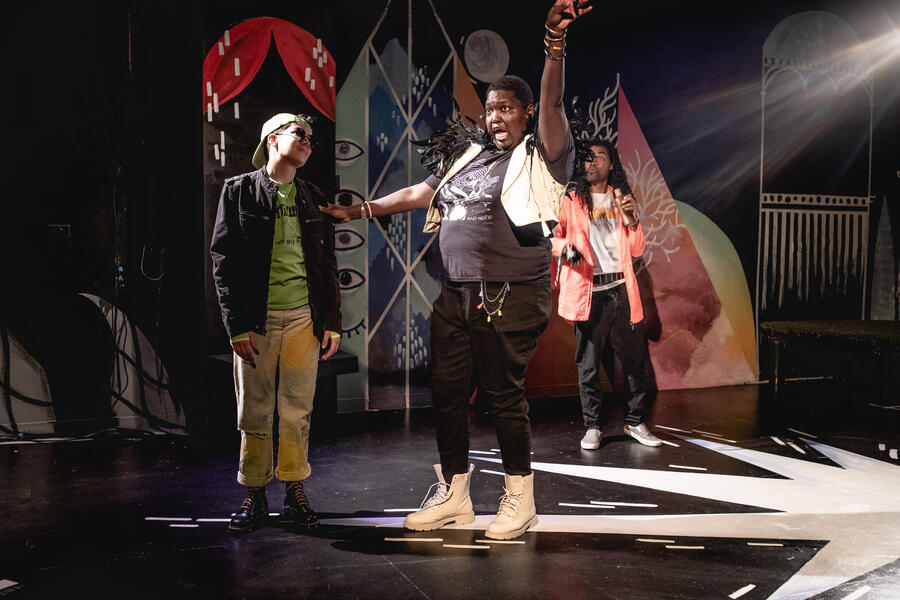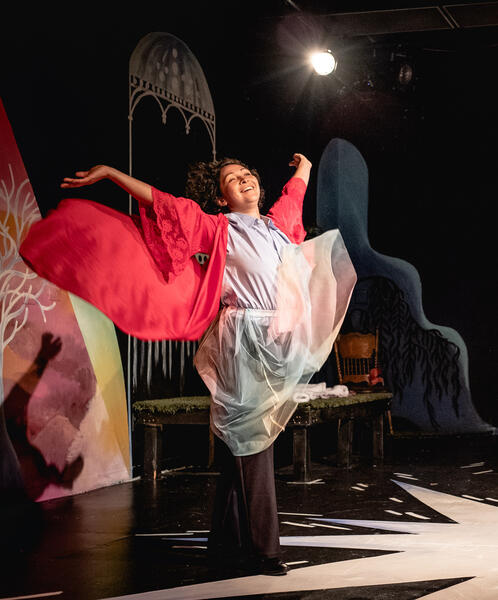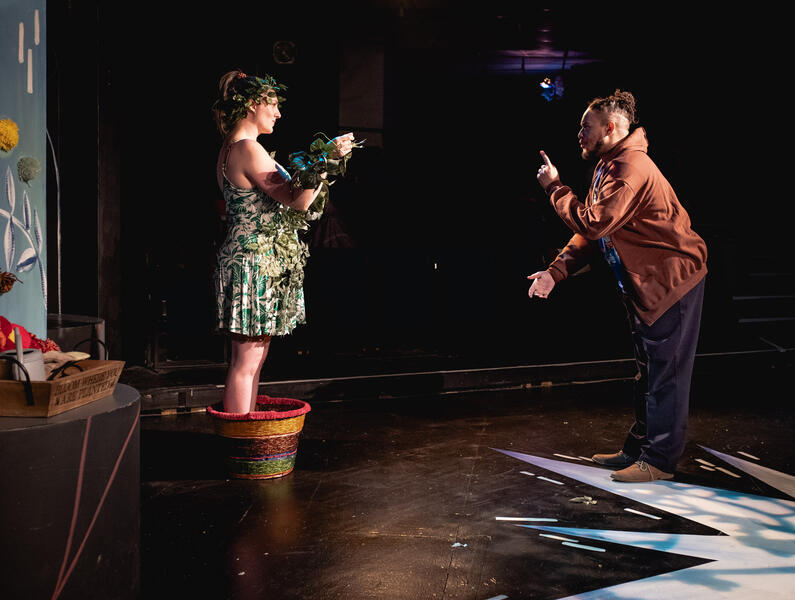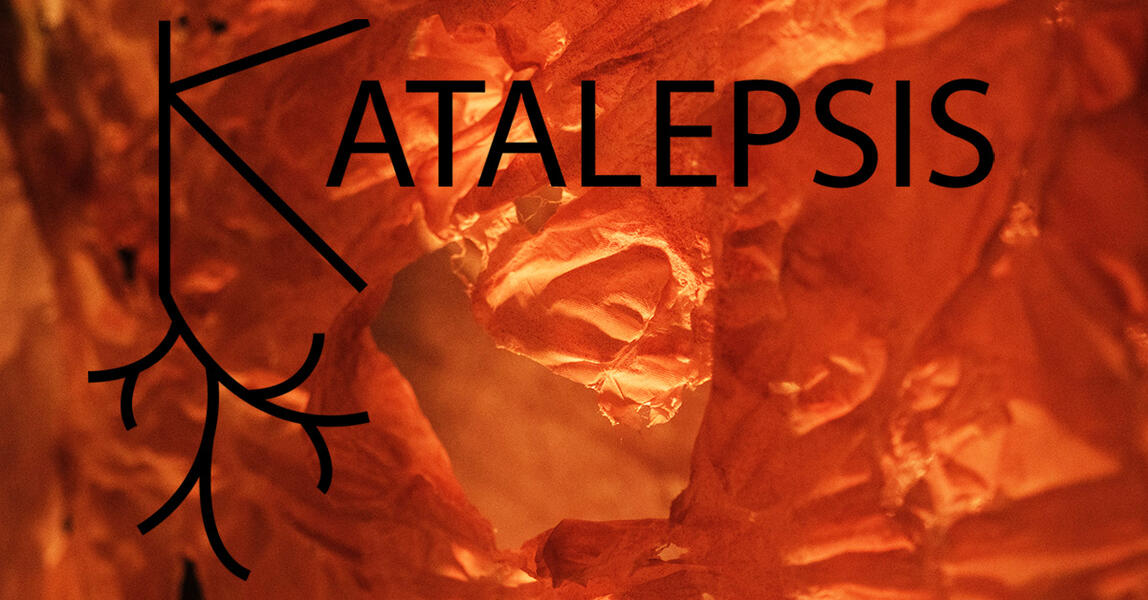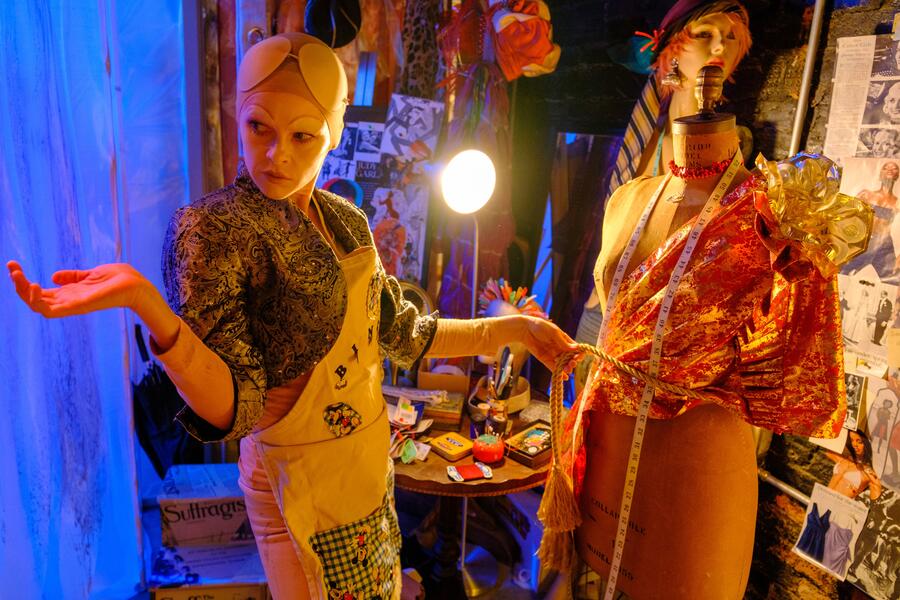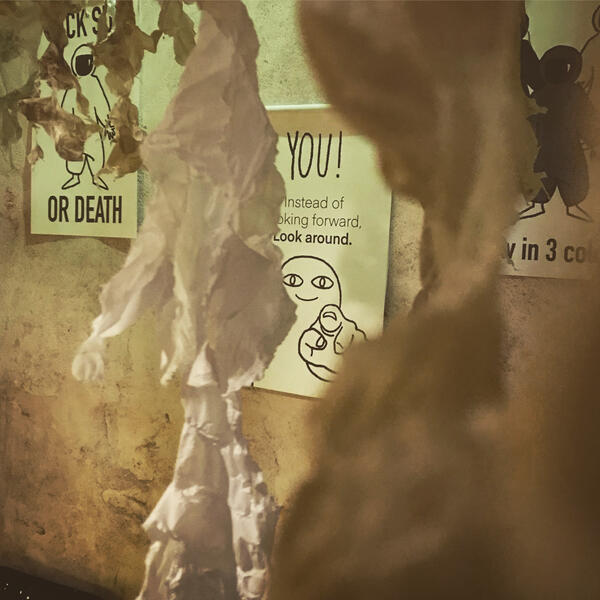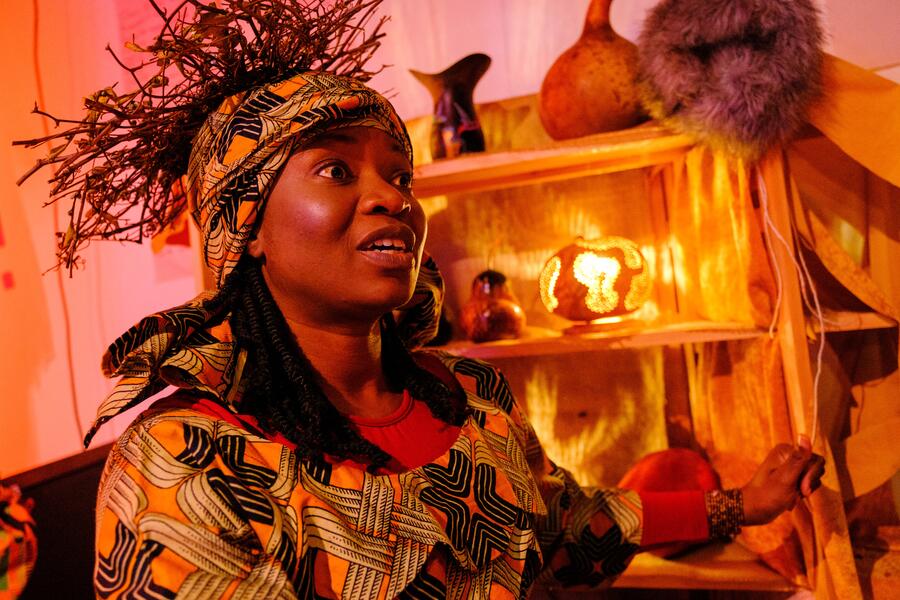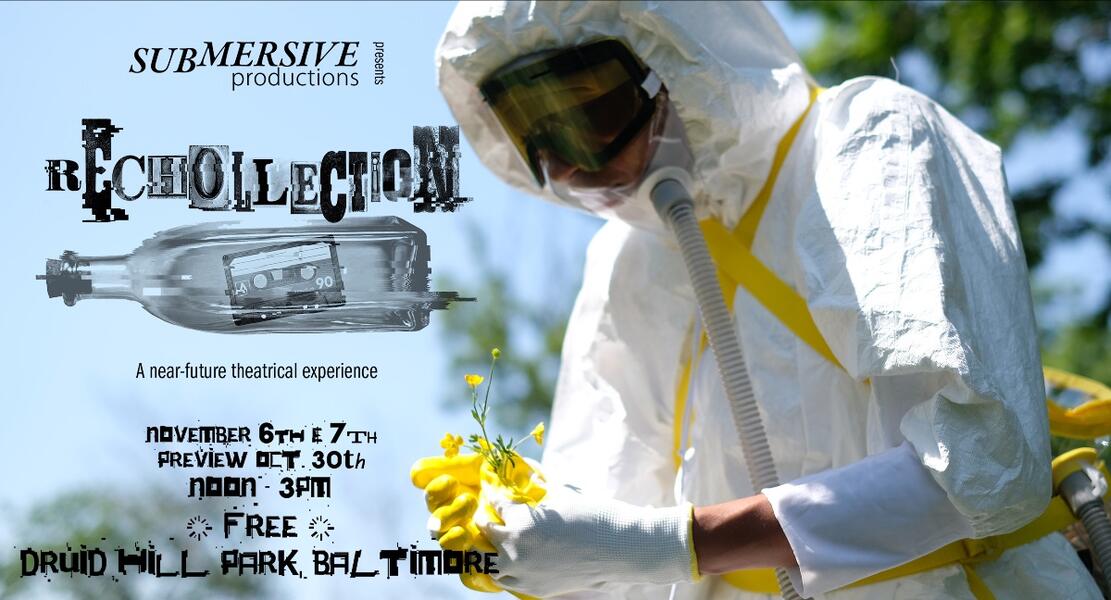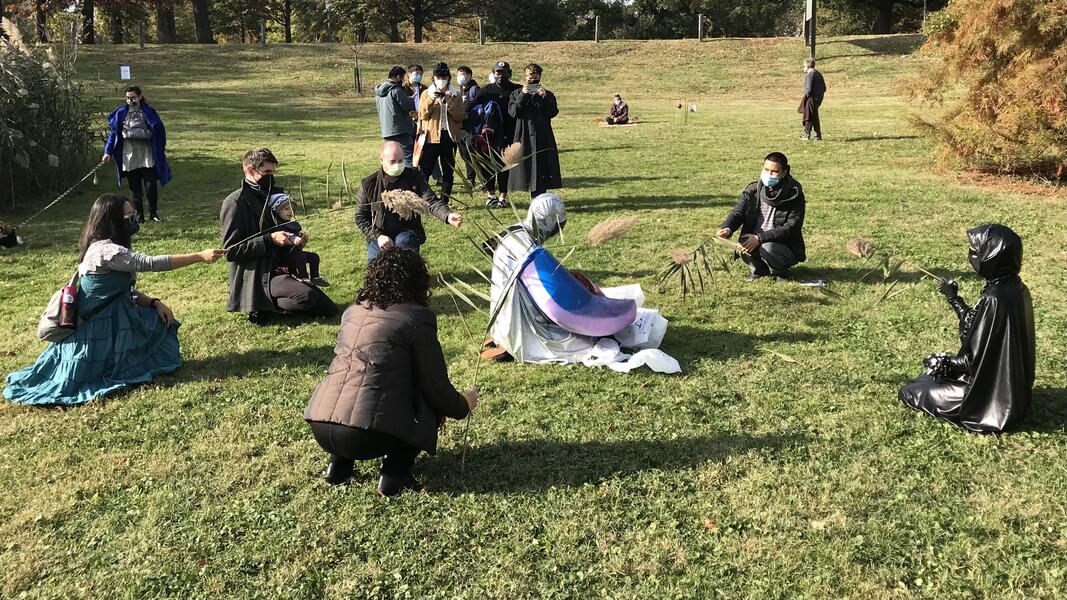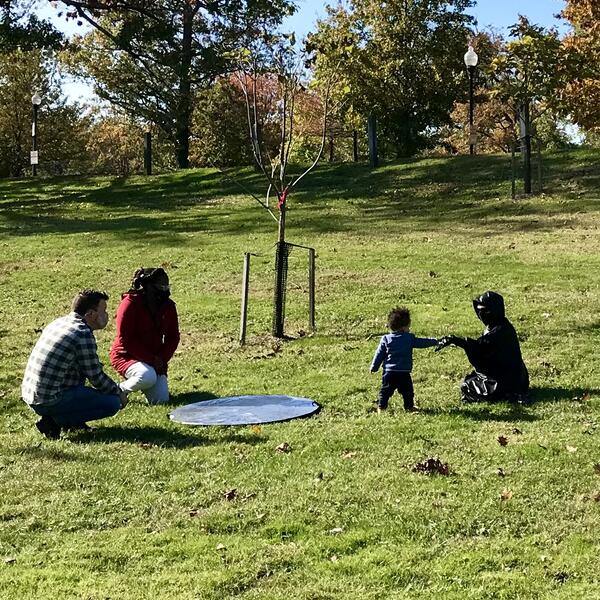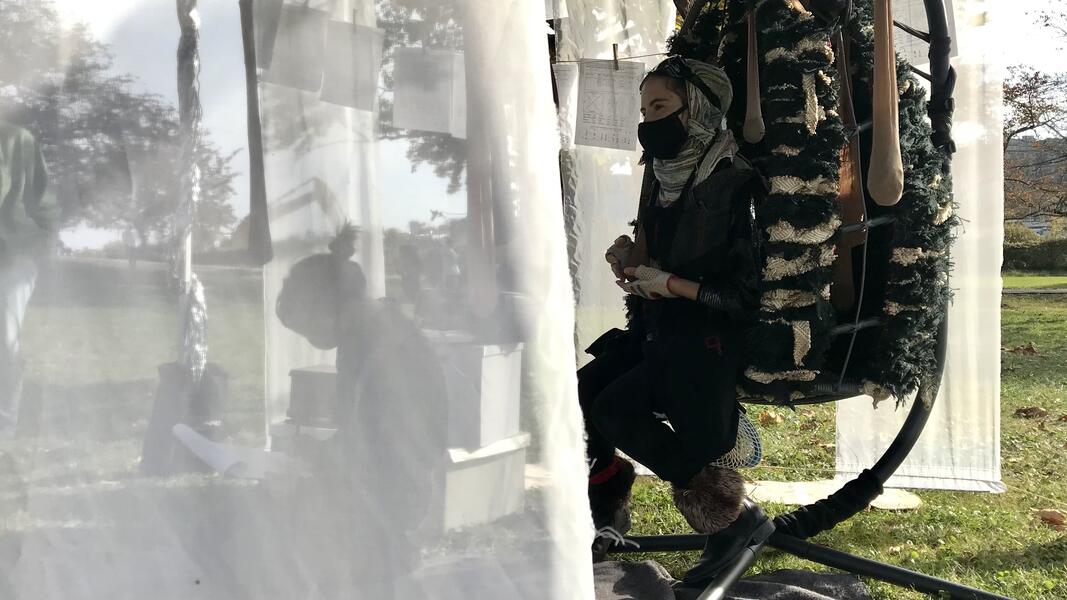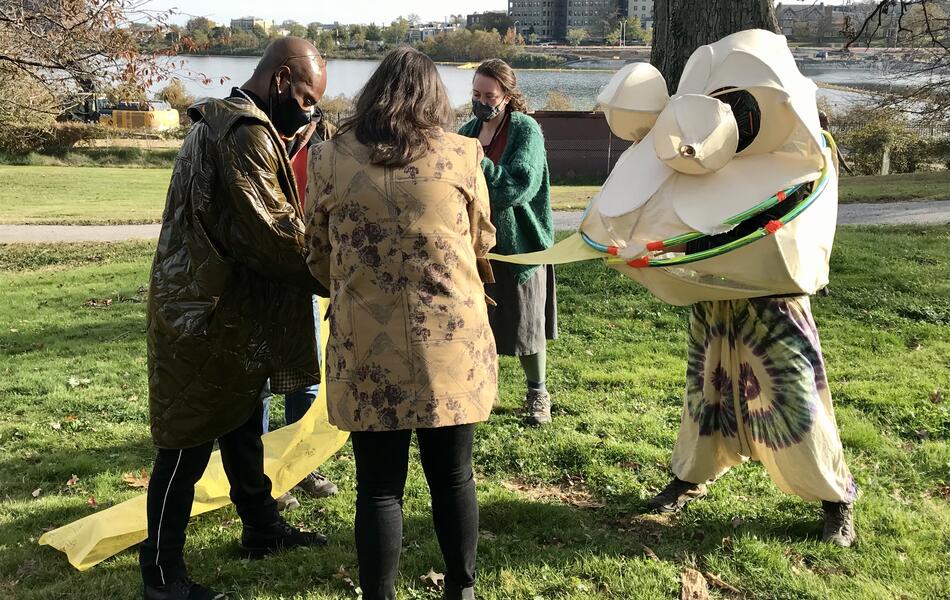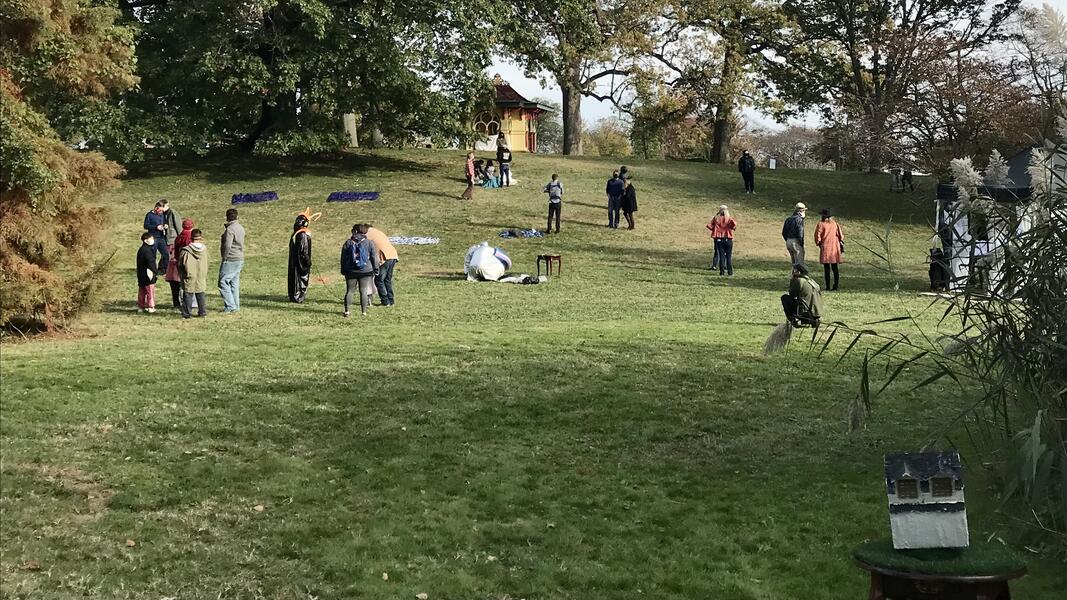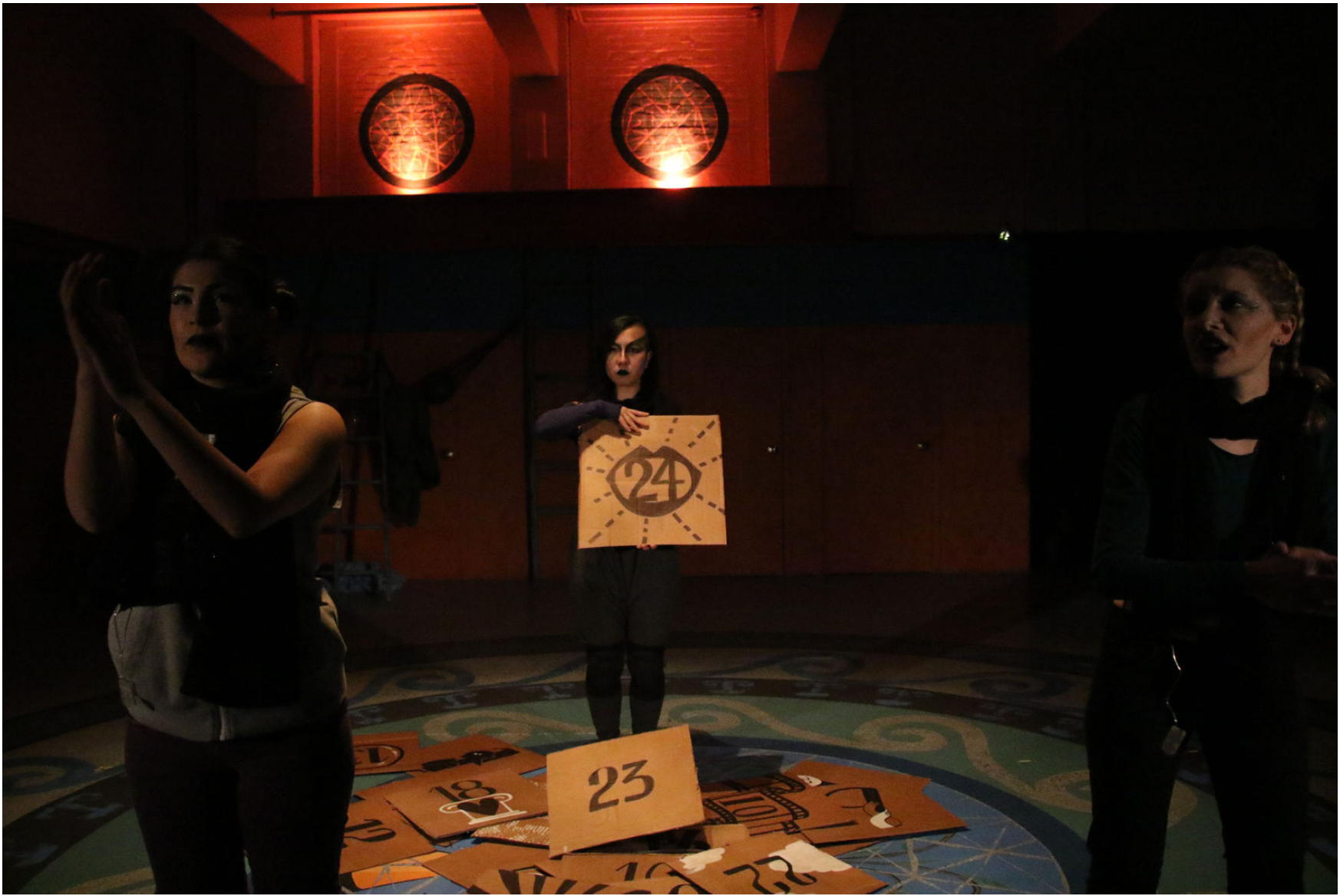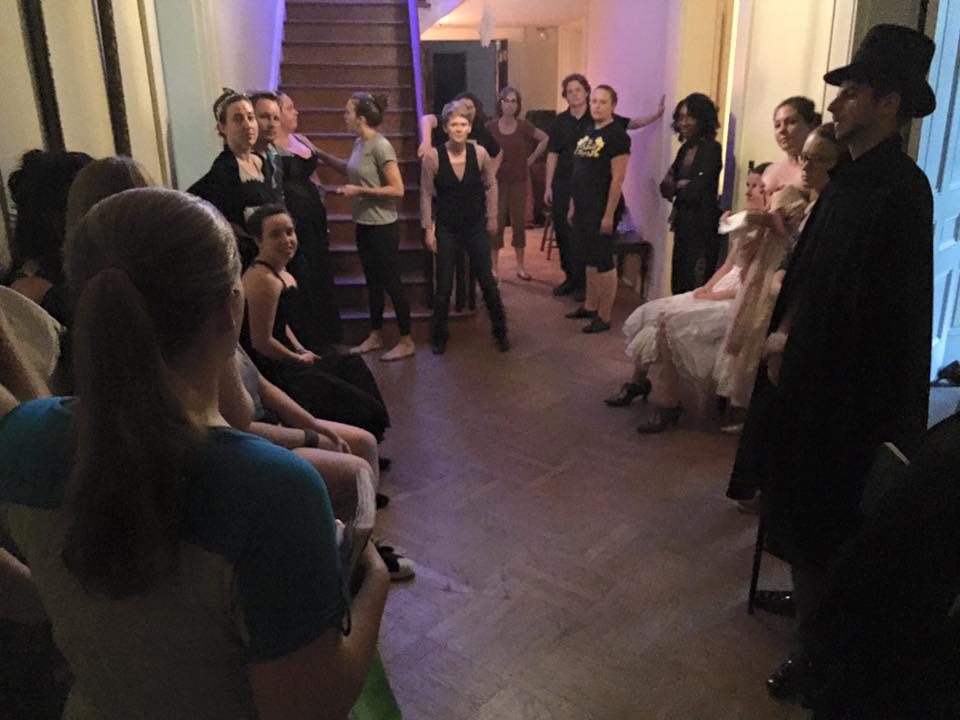Work samples
-
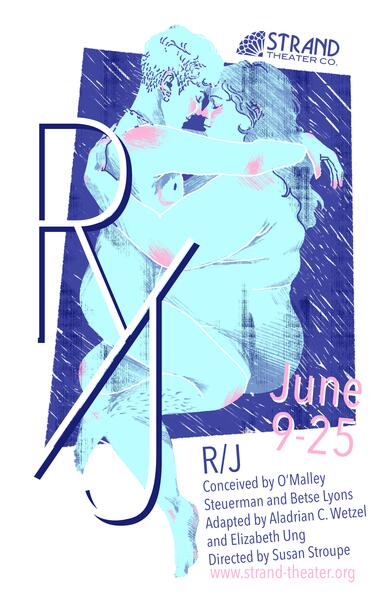 R/J (Strand Theater, 2023)Role: Director. R/J was an adaptation of Romeo & Juliet conceived by O'Malley Steuerman and Betse Lyons, adapted script by Aladrian Crowder Wetzel and Elizabeth Ung, as well as significant contributions from the acting ensemble. Centering queer experiences and bodies of many genders and shapes, R/J both updated and re-explored the original text in a way that reminded us all why that play is so enduring. With a passion to have audiences both hear and see new text and original text with new ears and eyes, we worked hard to blend contemporary and original heightened text, to uncover and uplift queerness in every part of the world of the play, and be body enthusiasts in our design and staging elements.
R/J (Strand Theater, 2023)Role: Director. R/J was an adaptation of Romeo & Juliet conceived by O'Malley Steuerman and Betse Lyons, adapted script by Aladrian Crowder Wetzel and Elizabeth Ung, as well as significant contributions from the acting ensemble. Centering queer experiences and bodies of many genders and shapes, R/J both updated and re-explored the original text in a way that reminded us all why that play is so enduring. With a passion to have audiences both hear and see new text and original text with new ears and eyes, we worked hard to blend contemporary and original heightened text, to uncover and uplift queerness in every part of the world of the play, and be body enthusiasts in our design and staging elements. -
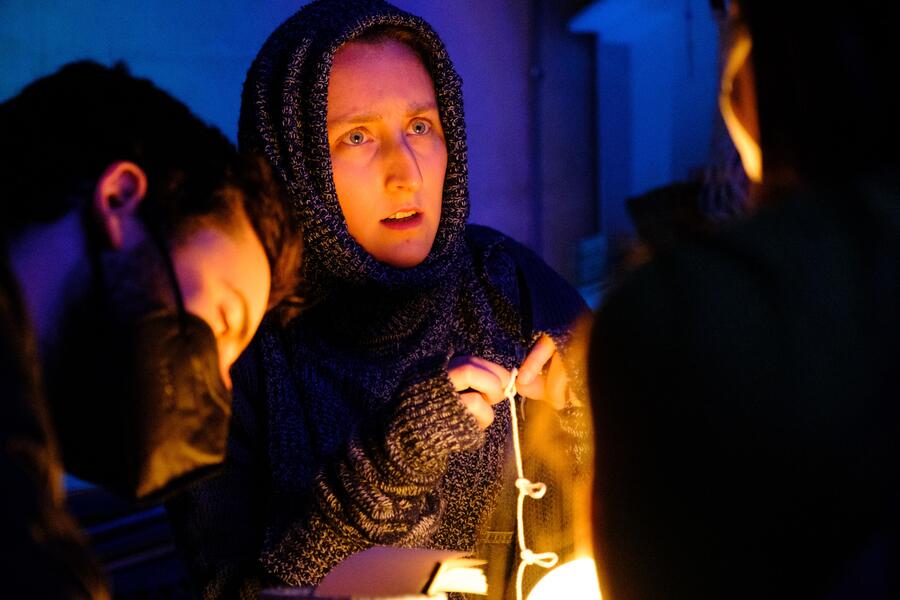 Katalepsis (Submersive Productions, 2023)Role: Core Team member with a focus on acting and dramaturgy/world-building. While performed in the spring of 2023, Katalepsis was originally conceived in 2019, which was deeply ironic given that the narrative centered on artists isolated by a deadly pandemic. In the most simplest terms, Katalepsis was about humans who find themselves living in a time when humans are no longer the dominant species, and how we find ways to connect to each other when most paths to connection are gone. Our longest devising period by far, the process of creating the show often paralleled our own emotional and physical journey through the pandemic.
Katalepsis (Submersive Productions, 2023)Role: Core Team member with a focus on acting and dramaturgy/world-building. While performed in the spring of 2023, Katalepsis was originally conceived in 2019, which was deeply ironic given that the narrative centered on artists isolated by a deadly pandemic. In the most simplest terms, Katalepsis was about humans who find themselves living in a time when humans are no longer the dominant species, and how we find ways to connect to each other when most paths to connection are gone. Our longest devising period by far, the process of creating the show often paralleled our own emotional and physical journey through the pandemic. -
Excerpt from HT Darling's Incredible Musaeum (Submersive Productions, 2017)
Excerpt from H.T. Darling's Incredible Musaeum (Submersive Productions, 2017) Role: Co-Director (Performance) with Lisi Stoessel and Glenn Ricci. "The Mastodon Scene" is the culminating scene of the two-hour devised, immersive production of H.T. Darling's Incredible Musaeum. This scene was performed on the third floor of the Peale Museum, a space we left intentionally unfinished-looking and blocked off from the audience until this scene, was the first time all the characters and audience were in the same space, where all the narrative threads came together for the end of the narrative of the two protagonists (Trustina Sabah's Aku Maxilla/The Humanoid Specimen & Sarah Olmsted Thomas' HT Darling). Although the show did not end here, the largely wordless movement sequence was very much felt as the "climax" of the show.
-
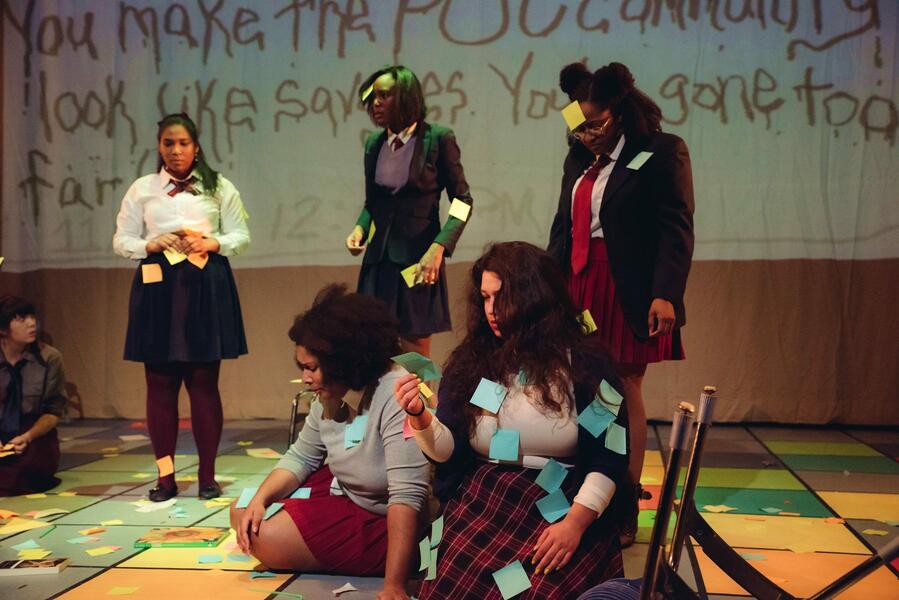 The Goodies (based on the Salem Witch Trials, 2017)The Goodies (based on the Salem Witch Trials, 2017) Role: Conceiver & Director. THE GOODIES was an ensemble devised play, produced by Iron Crow theater in 2017. The concept was of a modern retelling of the Salem Witch Trials, through the lens of contemporary racism, and what has now come to be called "cancel culture." With a cast of all women of color, we started with the question: "What if we believed the teenage girl accusers of Salem?" and, as an ensemble, created characters and wrote a script about a group of high school girls who mysteriously become ill due to the racism they experience in school, and the complex and tragic way of the adults in their lives preferred to shut them up by purging the "racists" from the school and saying it was fixed, rather than dig deeper to uproot the system of racism that poisoned everyone. The above image is from towards the end of the play, when the world, through Twitter (represented by illustrated projections and sticky notes the actors "posted" to their own bodies), suddenly turns on the girls after previously pushing them to keep naming racists. Actors featured here are (back row L-R): Elizabeth Ung, Alex Reeves, Aladrian Wetzel, Danie Harrow; (front row L-R): Dana Woodson, Jess Rivera. As a white artist who conceived and directed this piece, I knew that I needed to have the cast of actors of color lead this process--it was their personal stories and experiences that became fictionalized and tied together into a narrative, and while it was a very difficult play for them to perform and for audiences to experience, I believe everyone (including myself) walked away forever changed. My desire was for what I knew to would be a majority white audience to feel implicated at some point, to reexamine how they view the Salem Witch Trials: not as religious fanatics gone insane (something that liberal white people can easily distance ourselves from), but a highly intelligent, purity-pursuing modern people, from whom the White people of the US have inherited the majority of our culture.
The Goodies (based on the Salem Witch Trials, 2017)The Goodies (based on the Salem Witch Trials, 2017) Role: Conceiver & Director. THE GOODIES was an ensemble devised play, produced by Iron Crow theater in 2017. The concept was of a modern retelling of the Salem Witch Trials, through the lens of contemporary racism, and what has now come to be called "cancel culture." With a cast of all women of color, we started with the question: "What if we believed the teenage girl accusers of Salem?" and, as an ensemble, created characters and wrote a script about a group of high school girls who mysteriously become ill due to the racism they experience in school, and the complex and tragic way of the adults in their lives preferred to shut them up by purging the "racists" from the school and saying it was fixed, rather than dig deeper to uproot the system of racism that poisoned everyone. The above image is from towards the end of the play, when the world, through Twitter (represented by illustrated projections and sticky notes the actors "posted" to their own bodies), suddenly turns on the girls after previously pushing them to keep naming racists. Actors featured here are (back row L-R): Elizabeth Ung, Alex Reeves, Aladrian Wetzel, Danie Harrow; (front row L-R): Dana Woodson, Jess Rivera. As a white artist who conceived and directed this piece, I knew that I needed to have the cast of actors of color lead this process--it was their personal stories and experiences that became fictionalized and tied together into a narrative, and while it was a very difficult play for them to perform and for audiences to experience, I believe everyone (including myself) walked away forever changed. My desire was for what I knew to would be a majority white audience to feel implicated at some point, to reexamine how they view the Salem Witch Trials: not as religious fanatics gone insane (something that liberal white people can easily distance ourselves from), but a highly intelligent, purity-pursuing modern people, from whom the White people of the US have inherited the majority of our culture.
About Susan

Susan Stroupe is a collaborative theater maker, primarily working as a director, ensemble deviser, and teaching artist, who specializes in immersive and devised works of theater, often performed in non-traditional spaces. Throughout her career, Stroupe has worked as a director, performer, writer, puppeteer, teacher, and collaborator in professional and professional community-based projects, with actors and nonactors of many ages and many abilities and disabilities, all around the country. … more
Director: R/J (Strand Theater)
The project was conceived by Baltimore theater makers Betse Lyons and O'Malley Steuerman, who asked me to come on as Director. Over the course of several years of development in the pandemic, we cast a diverse ensemble of actors to work with writers Aladrian Crowder Wetzel and Elizabeth Ung to adapt the script, only keeping in tact the Shakespearean language between Romeo and Juliet.
While I often work with experimental and devised work, I love working with and directing classical text like Shakespeare, and I love digging into the founder of English language theater all these centuries later. Not because Shakespeare is perfect, but because the texts are wide and deep enough to find relevance and profundity every time. Working with the original text, the ensemble easily found connection to two families who were doing their best to keep their biological and chosen families safe. For this project, my job was not only to guide the actors in character creation and staging, but also to help them create an ensemble of trust, interdependence, and collaboration for an epic and vulnerable project.
Core Deviser, Acting and Dramaturgy: Katalepsis (Submersive Productions)
No longer needing to explain the emotions of being in a pandemic to our audiences, we sent the world of the show into the far future and instead of the logic of a pandemic, began to focus first on the effects of long-term isolation, the nature of creativity and creation, and eventually, the shift of philosophy and focus when humans are no longer the dominant species.
Much like previous Submersive shows, we set Katalepsis in a time and place one could call "dystopian," but were more interested in envisioning alternative futures to the ones in the steady stream of books, films, and TV filled with violence, domination, and grim endings. What if rather than fear, we started with creativity and wonder? What if rather than mysterious corporate or alien overlords enslaving the rest of humanity, we followed the natural evolution of mycelia to be the dominate species?
Katalepsis was the most challenging show we've ever done, and in the end we found that audiences responded in deeply emotional and resonate ways.
Core Deviser, Acting and Dramaturgy: rECHOllection (Submersive Productions)
Director: This Remains (University of Maryland, Baltimore County)
This Remains was a site-specific, ensemble-devised show directed by Susan Stroupe, created with UMBC students. It was the first in-person show at UMBC since the fall of 2019, and was performed in the spaces outside the Performing Arts Building. Audiences traversed the spaces with Guide characters through a world between the living and the dead, meeting the Lost Roamers and witnessing the stories of the Oracles.
Artist process statement: This Remains marked my first time directing a fully devised, immersive performance working with student performers, designers, and crew, as well as the first time UMBC had embarked on such a large-scale project. Students created original characters based on research into myth and folklore from different cultures, wrote their own scripts of new myths folktales, as well as dialogue to improvise with the audience. Over the course of devising, students collaborated on scenic and costume design, as well as learned how to give each other feedback for work that was in process and deeply personal. Our student stage management team learned an abundance of new skills as they not only had to learn about how to manage a show that was in process, but also how to manage and keep safe an audience that needed to be divided in groups and travel to all the different scenes without running into each other missing any stops. The show was highly successful, with most performances sold out and students from all over campus suddenly paying attention to what was going on at the Performing Arts Building.
Every step of this show was both a challenge and a joy, and what continues to stick with me is the transformations the students made as they explored often far outside their previous experience of acting, design, or stage management, and the pride they clearly felt in themselves for their artistic growth.
-
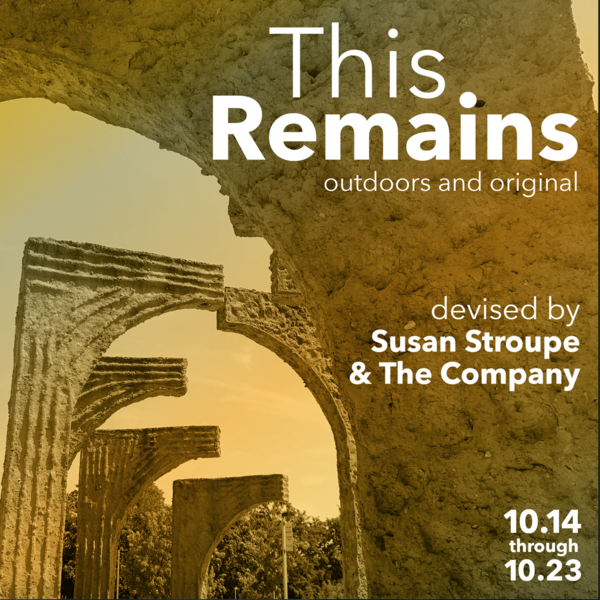 This Remains posterPoster for This Remains
This Remains posterPoster for This Remains -
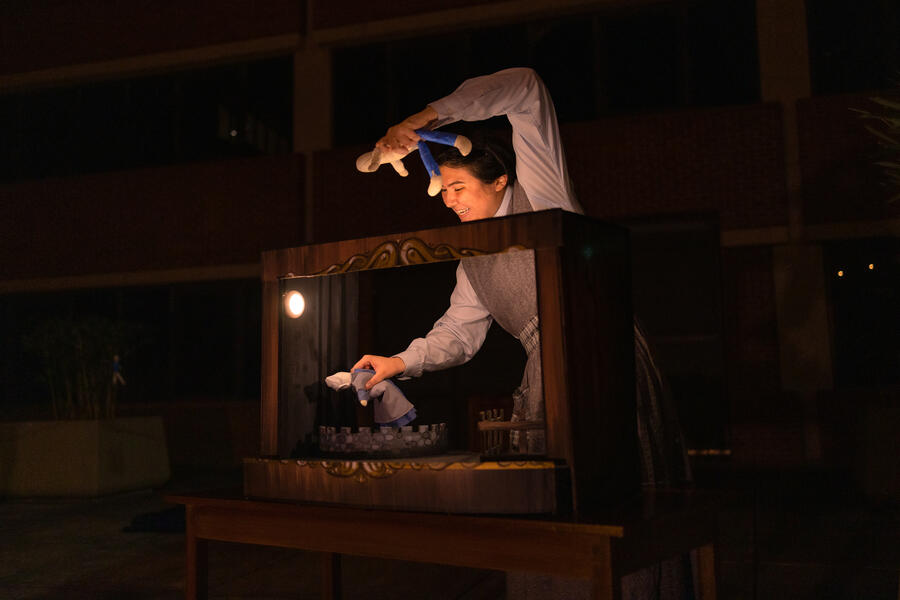 This Remains PerformerIn this photo, student Michelle Chaney performs her original short piece in which she rewrote and re-imagined the telling of Rapunzel, using puppets and found objects. She created a beautiful, minimal text that she juxtaposed with an increasingly vulnerable movement-based narrative for her character, and I heard from many audience members how transformative and profound her piece was. Additionally, I heard from many faculty how surprised they were by how much Michelle seemed to have bloomed as a performer. Photo by Kiirstn Pagan
This Remains PerformerIn this photo, student Michelle Chaney performs her original short piece in which she rewrote and re-imagined the telling of Rapunzel, using puppets and found objects. She created a beautiful, minimal text that she juxtaposed with an increasingly vulnerable movement-based narrative for her character, and I heard from many audience members how transformative and profound her piece was. Additionally, I heard from many faculty how surprised they were by how much Michelle seemed to have bloomed as a performer. Photo by Kiirstn Pagan -
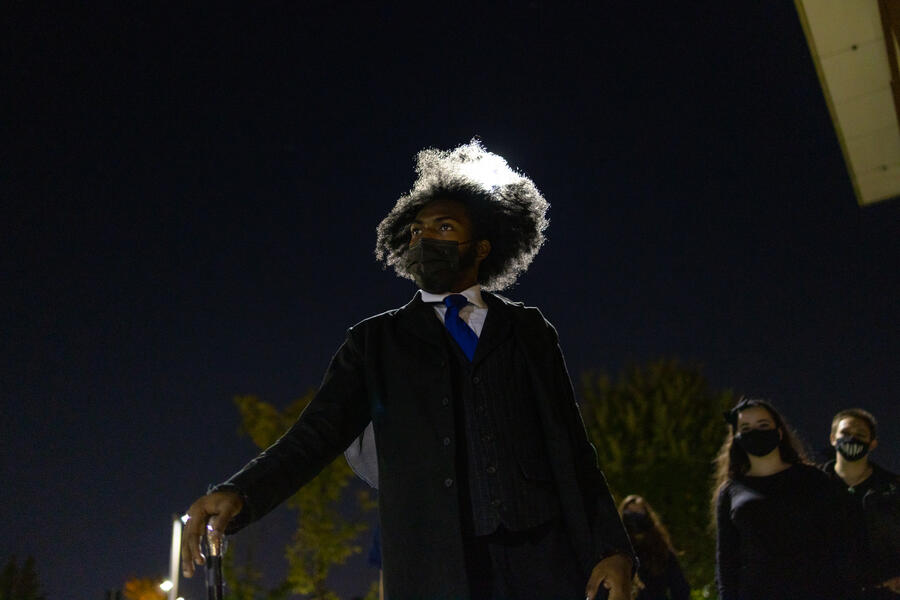 This Remains Guide.jpgFor This Remains, we had four students take on the role of a guide, creating an original character who would lead the audience around to the different storytelling stations of the Oracles. Each guide character was vastly different and students who took on these roles had to sharpen their skills in engaging directly with the audience the entire show while both staying in character and also keeping an eye out for any mishaps or slow-downs in case they needed to adjust their pace or reroute. All students in this role deeply developed their listening and reacting skills in acting, as they began to realize over the course of the rehearsal process that they would have to be ready to respond to many different kinds of personalities, levels of engagement, and needs. Student Marlon Brown (pictured above) spoke many times of learning about finding the balance between what he wanted to do as a character and what the audience needed from him to fully engage.
This Remains Guide.jpgFor This Remains, we had four students take on the role of a guide, creating an original character who would lead the audience around to the different storytelling stations of the Oracles. Each guide character was vastly different and students who took on these roles had to sharpen their skills in engaging directly with the audience the entire show while both staying in character and also keeping an eye out for any mishaps or slow-downs in case they needed to adjust their pace or reroute. All students in this role deeply developed their listening and reacting skills in acting, as they began to realize over the course of the rehearsal process that they would have to be ready to respond to many different kinds of personalities, levels of engagement, and needs. Student Marlon Brown (pictured above) spoke many times of learning about finding the balance between what he wanted to do as a character and what the audience needed from him to fully engage. -
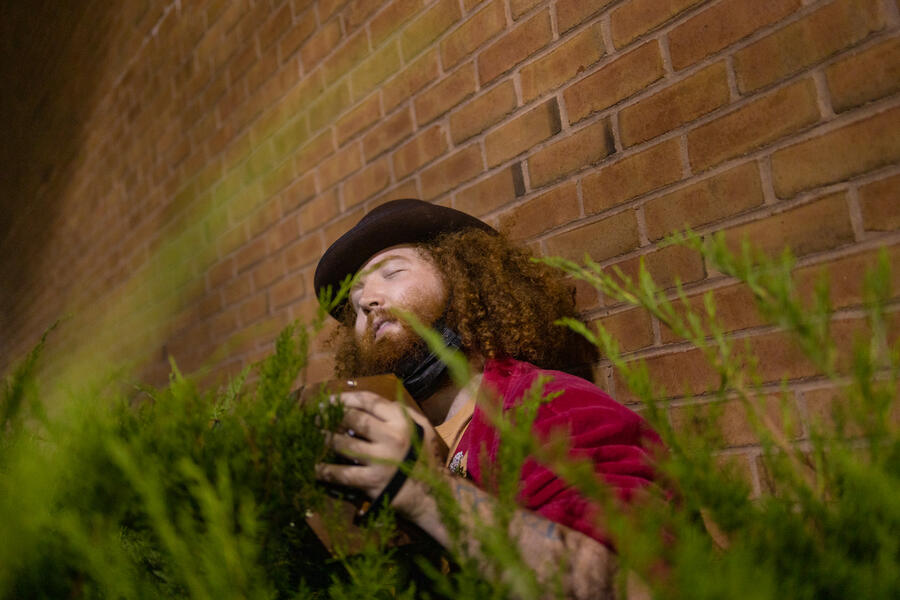 This Remains PerformerThe third group of characters were the Roamers, who acted as tricksters and clowns, roaming freely among traveling audience and storytellers, often adding interstitial or improvised scenes with audience and Guides as the show went on. Student Mykey Carpenter acted as both a collaborator and a mentor for the younger Roamer characters; one of the big challenges for students coming back in-person was all the lost in-person training time, and as a senior who had gotten the most in-person training pre-pandemic, Mykey generously offered skill-building, feedback, and encouragement to students who were performing for a live audience for the first time in years. Additionally, he got to showcase his abundant clowning skills by being able to create an original character that fit the skills he wanted to explore.
This Remains PerformerThe third group of characters were the Roamers, who acted as tricksters and clowns, roaming freely among traveling audience and storytellers, often adding interstitial or improvised scenes with audience and Guides as the show went on. Student Mykey Carpenter acted as both a collaborator and a mentor for the younger Roamer characters; one of the big challenges for students coming back in-person was all the lost in-person training time, and as a senior who had gotten the most in-person training pre-pandemic, Mykey generously offered skill-building, feedback, and encouragement to students who were performing for a live audience for the first time in years. Additionally, he got to showcase his abundant clowning skills by being able to create an original character that fit the skills he wanted to explore.
Core Deviser, Dramaturg, Performer: MASS/Rabble (Submersive Productions)
Role: Core Devising Team, with Lisi Stossel, Glenn Ricci, Ursula Marcum, in partnership with Berlin-based Butoh artist Yuko Kaseki: Devising Dramaturg, Ensemble Performer. Performed at the Baltimore War Memorial, April 2019.
Show description: As our bodies move, we tell a story. Where we have been, where we are going, what we hold on to, what we let go of. When bodies move in masses, they tell a larger story. Hope, fear, war, famine, the search for a better life. What does it mean to be just one body moving in humanity’s great crowd? This is a movement piece. Prepare to be moved.
“MASS/RABBLE” had the audience of up to 100 join a diverse ensemble of thirty movers to explore themes of mass migration and the borders and boundaries that separate us, using Butoh as a base for exploration and devising. The devising rehearsal process took place over several stages and many months, going through an evolution from conceptional ideas and images to a wordless physical narrative, through much physical training, improvisation, ensemble building, and dramaturgical discussion.
My role was two cull and curate the wide array of ideas and concepts we were putting into the show into the kinds of leading/open questions that would help the ensemble turn concept into narrative movement, as well as to keep a targeted eye on how the show was shaping us as a whole, particularly in how we involved/invited our audiences in a wordless movement piece. Additionally, I was for the first time part of the performance ensemble in a Submersive production (since being a Founding Member my role has always been as a director), which was a challenge for me to balance my process as a performer with my leadership position as a Core Deviser and Dramaturg for all the performers.
-
MASS/RABBLE Trailer
Our trailer for Mass/Rabble created by Glenn Ricci; the music accompanying it is composed by Glenn Ricci, who composed the entire soundtrack (and is Submersive's resident Sound Designer). During the show, this particular track scored the end of the entire show, when the performers and most of the audience were laying on the ground watching a lighting animation (designed by Helen Garcia-Alton).
-
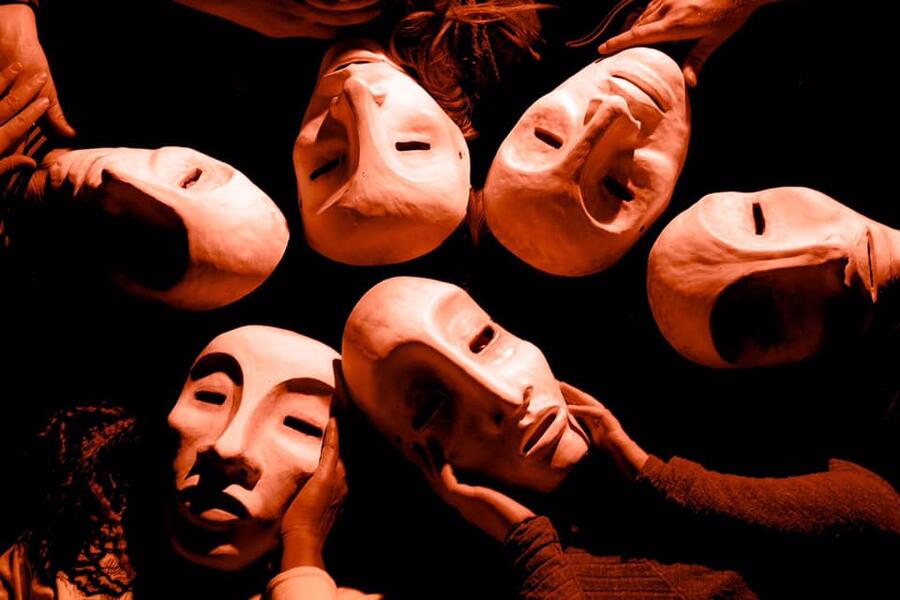 MASS/Rabble Masks
MASS/Rabble Masks -
 MASS/Rabble Masks in Action
MASS/Rabble Masks in Action -
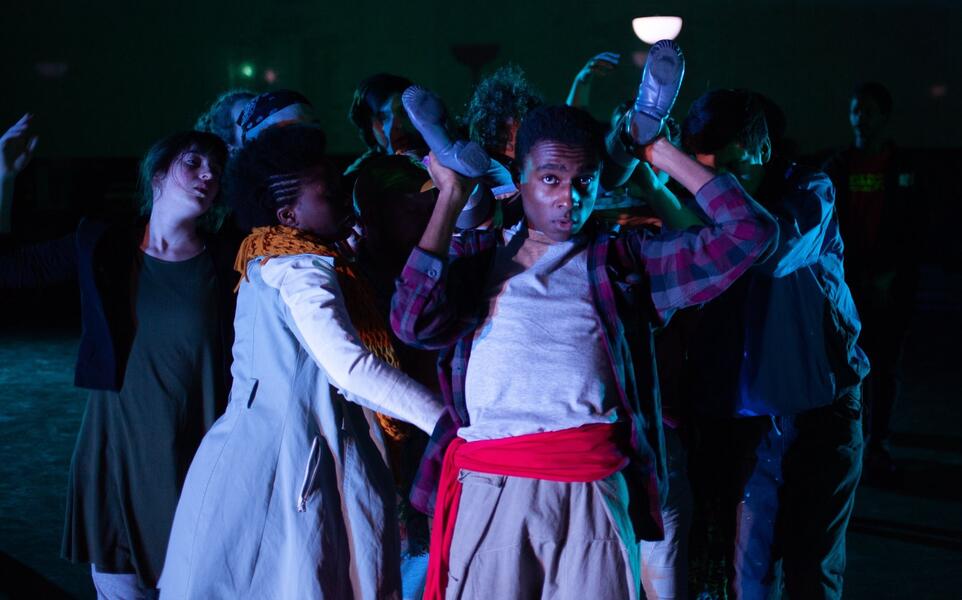 MASS/Rabble Carrying the Children
MASS/Rabble Carrying the Children -
 MASS/Rabble The Four Tribes
MASS/Rabble The Four Tribes -
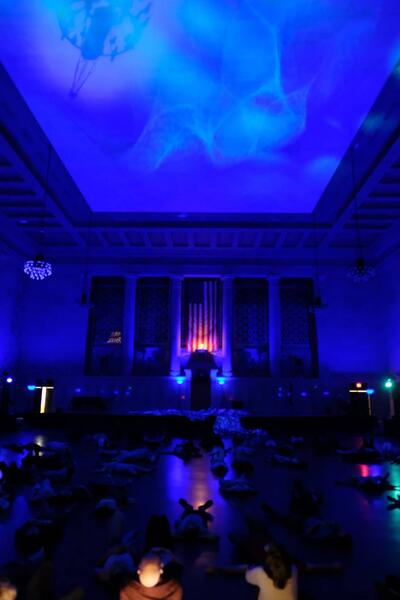 MASS/Rabble Ending
MASS/Rabble Ending
Core Deviser: Institute of Visionary History (Submersive Productions)
Since the concept was complicated, we on the Core Team (myself, Glenn Ricci, Ursula Marcum, and Josh Aterovis) broke down the process into three parts: 1. The Induction, where audience was introduced to the IVH, introduced to the experiment/question they'd be working on, and inducted into the Society as a researcher; 2. The Experiment, where the audience, deputized as researchers would enter the main experiment room on the third floor of the Peale, interacting with both the space (we built a wall that was essentially a giant puppet) and a performer who would interact with them in a number of different ways; 3. The Debrief, where the audience would go to a separate room to discuss with each other their findings, fill out a data sheet with different questions, and interact with more dramaturgical sources that might shed more light onto the topic.
Each episode was an entirely different world, and through both the questions we posed as the IVH and the pieces created by the 8 performers, we traversed time and space in innumerable ways, hopefully helping our audiences feel both reconnected to and disoriented by a past narrative they thought they understood. Our intention of the piece was to tear whole in the narrative of our history, in order to add in some new mythologies, narratives, and voices that may have previously been hidden.
-
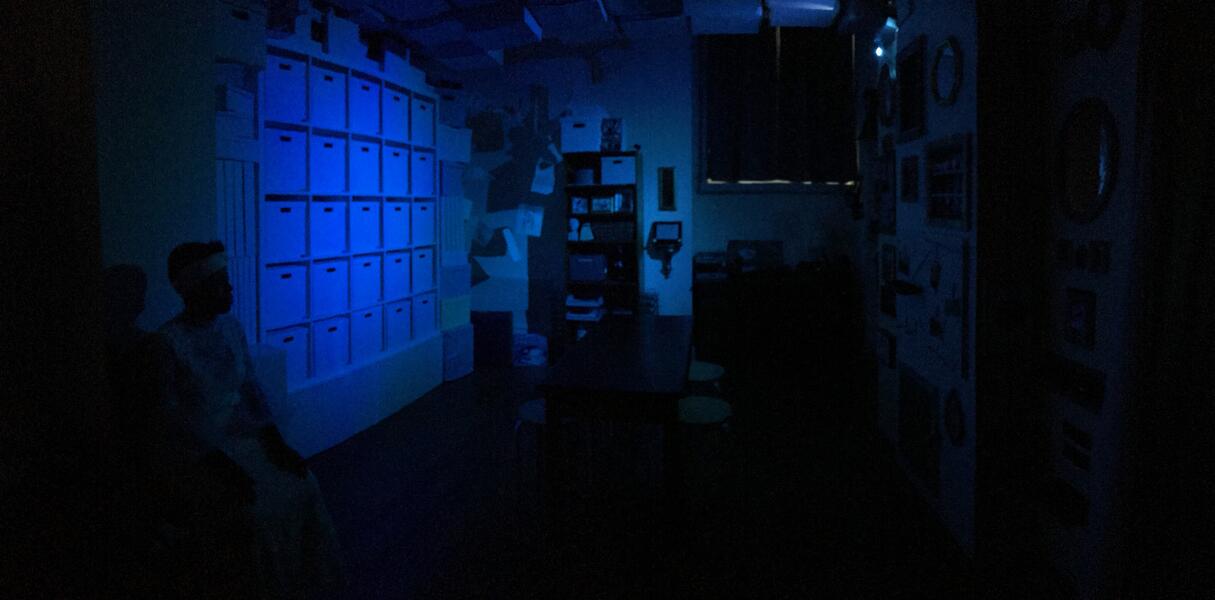 Episode One: You Think You Know MeEpisode One had the audience encountering a Harriet Tubman they probably had never before, inviting them to ponder how we each can contribute to preventing catastrophe, and our own complicity in the whitewashing of radical historical figures.
Episode One: You Think You Know MeEpisode One had the audience encountering a Harriet Tubman they probably had never before, inviting them to ponder how we each can contribute to preventing catastrophe, and our own complicity in the whitewashing of radical historical figures. -
 Episode One: You Think You Know MeEpisode One had the audience encountering a Harriet Tubman they probably had never before, inviting them to ponder how we each can contribute to preventing catastrophe, and our own complicity in the whitewashing of radical historical figures. We had two actors devising and performing this piece: Rachel Recking and Tina Canady.
Episode One: You Think You Know MeEpisode One had the audience encountering a Harriet Tubman they probably had never before, inviting them to ponder how we each can contribute to preventing catastrophe, and our own complicity in the whitewashing of radical historical figures. We had two actors devising and performing this piece: Rachel Recking and Tina Canady. -
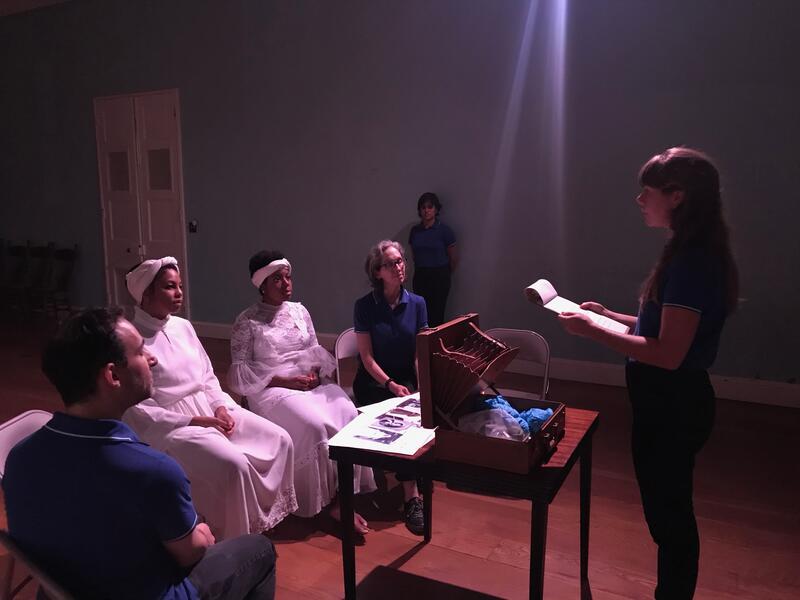 The Induction CeremonyThis photo is of a rehearsal for the Induction (so our actors for Episode One would know what the audience experienced), in which audience members were introduced to the Institute, introduced to the question of the experiment through photos and objects, and asked to take an oath of secrecy to join the Institute.
The Induction CeremonyThis photo is of a rehearsal for the Induction (so our actors for Episode One would know what the audience experienced), in which audience members were introduced to the Institute, introduced to the question of the experiment through photos and objects, and asked to take an oath of secrecy to join the Institute. -
 Episode One: You Think You Know MeA climactic moment of Episode One was when Harriet began to panic and sequestered herself, and the audience was required to create a prayer out of letter tiles to show up for her and bring her out of her moment of darkness. This was one of many of the very profound prayers that a group of audience had to collaborate on.
Episode One: You Think You Know MeA climactic moment of Episode One was when Harriet began to panic and sequestered herself, and the audience was required to create a prayer out of letter tiles to show up for her and bring her out of her moment of darkness. This was one of many of the very profound prayers that a group of audience had to collaborate on. -
 Episodes Two-Five QuartetThis is The Quartet for the middle four episodes. We were interested in making space for the Asian-American artists in our community, as they are often largely unrepresented in Baltimore art. Each performer/deviser created a singular piece after, as a quartet, they did initial ensemble work of connecting themes. Creator/Performers from Top Left: Mika Nakano, Kim Le, Cori Dioquino, Elizabeth Ung
Episodes Two-Five QuartetThis is The Quartet for the middle four episodes. We were interested in making space for the Asian-American artists in our community, as they are often largely unrepresented in Baltimore art. Each performer/deviser created a singular piece after, as a quartet, they did initial ensemble work of connecting themes. Creator/Performers from Top Left: Mika Nakano, Kim Le, Cori Dioquino, Elizabeth Ung -
 Episode Six: A Horse by the Tail in the NightLisi Stoessel and Francisco Benavides were the core deviser-performers on this 8-hour durational piece. Because of its length, we could not rehearse the piece all the way through, and so much of our time as a team was spent in figuring out smaller moments, figuring out how the performers and we as the production team would cue each other and help the piece move along, and creating a "tome" that determined the order of events. My role was largely to help Lisi and Francisco precisely define who the characters were in voice, text, movement, and intention, so that in the performance, they would not feel lost even when improvising, as well as helping to shape the whole piece.
Episode Six: A Horse by the Tail in the NightLisi Stoessel and Francisco Benavides were the core deviser-performers on this 8-hour durational piece. Because of its length, we could not rehearse the piece all the way through, and so much of our time as a team was spent in figuring out smaller moments, figuring out how the performers and we as the production team would cue each other and help the piece move along, and creating a "tome" that determined the order of events. My role was largely to help Lisi and Francisco precisely define who the characters were in voice, text, movement, and intention, so that in the performance, they would not feel lost even when improvising, as well as helping to shape the whole piece. -
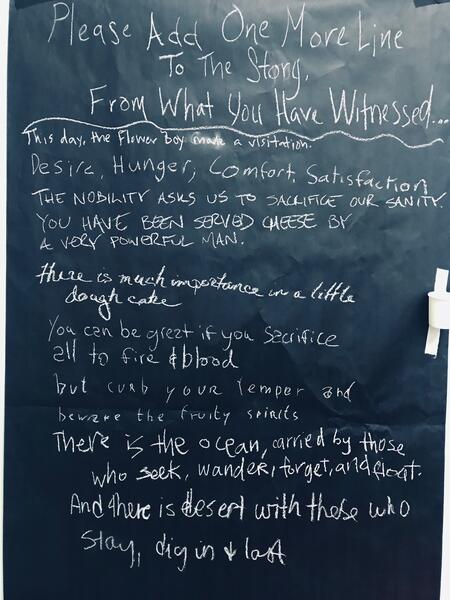 Episode Six DebriefBecause the piece was so long, we wanted audiences to be able to watch as much as they wanted even when they weren't in the Experiment Room. Audiences would buy tickets for one hour at a time, and after that, they were invited to stay in the Debriefing room, directly across from the Experiment Room, where they could watch the piece on a live feed, watch Glenn Ricci perform live sound, and contribute to the dramaturgy of the piece (pictured here).
Episode Six DebriefBecause the piece was so long, we wanted audiences to be able to watch as much as they wanted even when they weren't in the Experiment Room. Audiences would buy tickets for one hour at a time, and after that, they were invited to stay in the Debriefing room, directly across from the Experiment Room, where they could watch the piece on a live feed, watch Glenn Ricci perform live sound, and contribute to the dramaturgy of the piece (pictured here).
Director: LA LLORONA and THE ORPHAN SEA in Rep (Cohesion Theater)
The 9 actors we cast were a diverse group of performers who were challenged with learning two worlds, two roles, and in the case of THE ORPHAN SEA, doing a large amount of devising, both in movement and in the script. The script itself is largely left to interpretation, broken up only into scenes of the three choruses: The Penelope Chorus, the Odysseus Chorus, and the City Chorus. LA LLORONA required an enormous amount of dramaturgical research, both of the myth and of the specific, disparate indigenous, colonialist, and modern cultures of New Mexico.
-
 Cast of The Rep (with LA LLORONA playwright Cecelia Raker)We were fortunate to have Ceceila Raker join us for the beginning of our process, and pictured here, the last performance of LA LLORONA. From L-R: Chara Bauer, Laura Malkus, Christian Gonzalez, Emily Sucher, Jonathan Jacobs, Natanya Sheva Washer, playwright Cecelia Raker, Mani Yangilmau, Mia Ybarra, director Susan Stroupe, Mika Nakano, Stage Manager Betse Lyons.
Cast of The Rep (with LA LLORONA playwright Cecelia Raker)We were fortunate to have Ceceila Raker join us for the beginning of our process, and pictured here, the last performance of LA LLORONA. From L-R: Chara Bauer, Laura Malkus, Christian Gonzalez, Emily Sucher, Jonathan Jacobs, Natanya Sheva Washer, playwright Cecelia Raker, Mani Yangilmau, Mia Ybarra, director Susan Stroupe, Mika Nakano, Stage Manager Betse Lyons. -
 The Orphan SeaThe City Chorus of THE ORPHAN SEA
The Orphan SeaThe City Chorus of THE ORPHAN SEA -
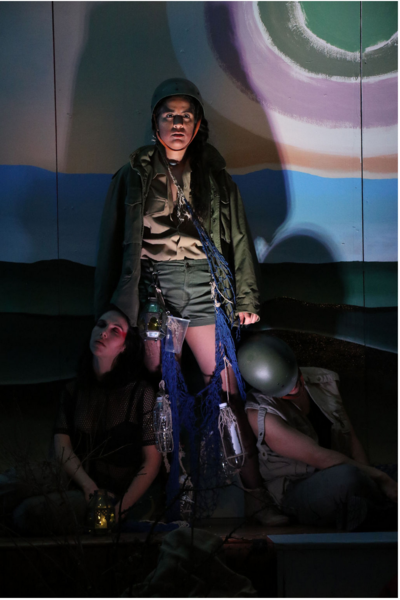 The Orphan SeaThe Odysseus Chorus of THE ORPHAN SEA
The Orphan SeaThe Odysseus Chorus of THE ORPHAN SEA -
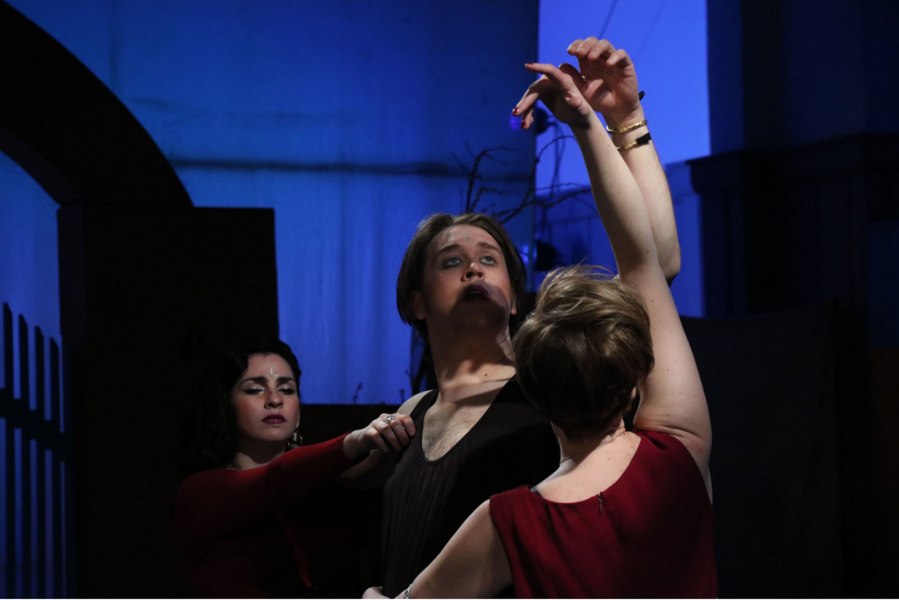 The Orphan SeaThe Penelope Chorus of THE ORPHAN SEA
The Orphan SeaThe Penelope Chorus of THE ORPHAN SEA -
 The Orphan SeaThe reunion of the Penelope and Odysseus Choruses of THE ORPHAN SEA
The Orphan SeaThe reunion of the Penelope and Odysseus Choruses of THE ORPHAN SEA -
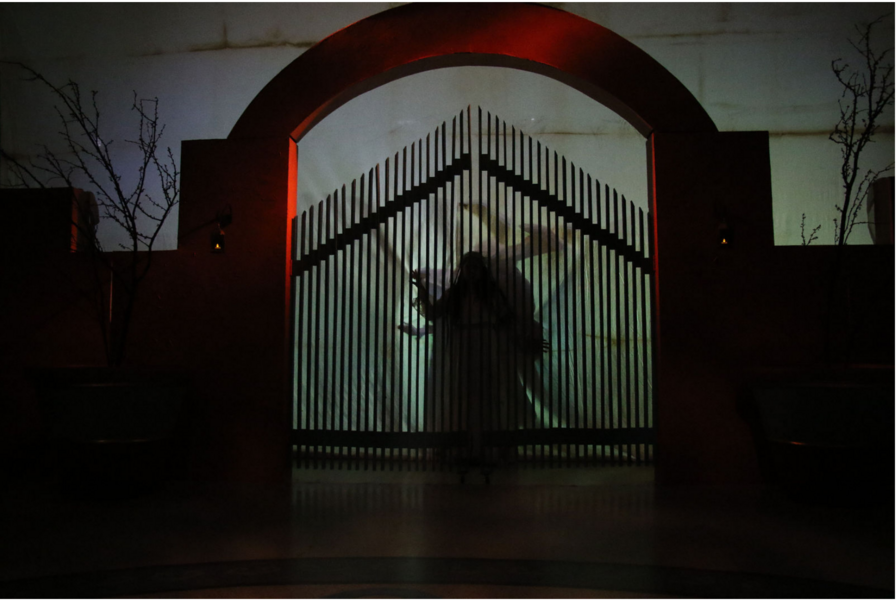 La LloronaLa Llorona (Mani Yangilmau) at the Gates of Heaven in LA LLORONA.
La LloronaLa Llorona (Mani Yangilmau) at the Gates of Heaven in LA LLORONA. -
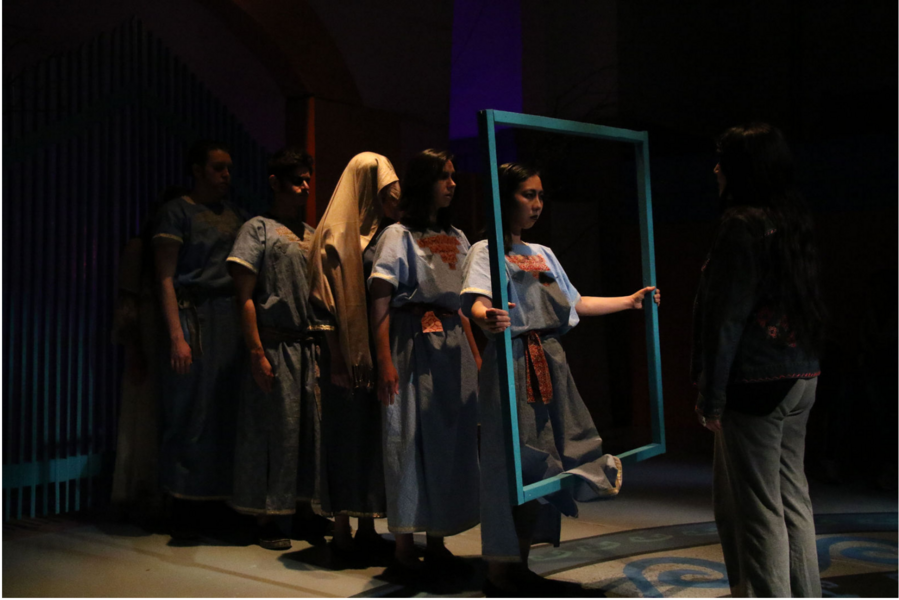 La LloronaMolly (Mia Ybarra) encounters her ancestors through a mirror in LA LLORONA
La LloronaMolly (Mia Ybarra) encounters her ancestors through a mirror in LA LLORONA -
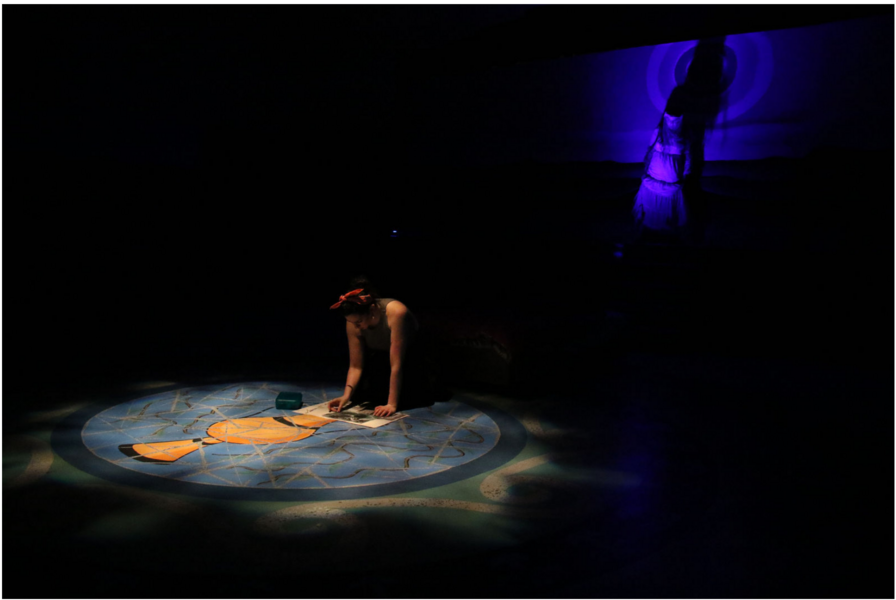 La LloronaLa Llorona (Mani Yangilmau) stalks Maria (Natanya Sheva Washer) in LA LLORONA.
La LloronaLa Llorona (Mani Yangilmau) stalks Maria (Natanya Sheva Washer) in LA LLORONA. -
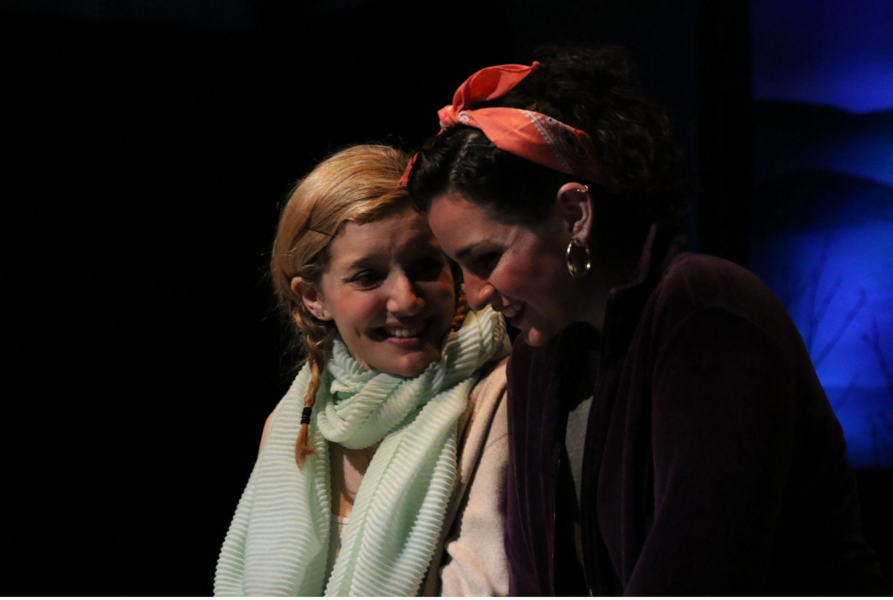 La LloronaRachel (Emily Sucher) and Maria (Natanya Sheva Washer) become friends in LA LLORONA.
La LloronaRachel (Emily Sucher) and Maria (Natanya Sheva Washer) become friends in LA LLORONA.
Conceiver & Director: THE GOODIES (Iron Crow Theater)
With a cast of all women of color, we started with the question: "What if we believed the teenage girl accusers of Salem?" and, as an ensemble, created characters and wrote a script about a group of high school girls who mysteriously become ill due to the racism they experience in school, and the complex and tragic way of the adults in their lives preferred to shut them up by purging the "racists" from the school and saying it was fixed, rather than dig deeper to uproot the system of racism that poisoned everyone.
As a white artist who conceived and directed this piece, I knew that I needed to have the cast of actors of color lead this process--it was their personal stories and experiences that became fictionalized and tied together into a narrative, and while it was a very difficult play for them to perform and for audiences to experience, I believe everyone (including myself) walked away forever changed. My desire was for what I knew to would be a majority white audience to feel implicated at some point, to reexamine how they view the Salem Witch Trials: not as religious fanatics gone insane (something that liberal white people can easily distance ourselves from), but a highly intelligent, purity-pursuing modern people, from whom the White people of the US have inherited the majority of our culture.
-
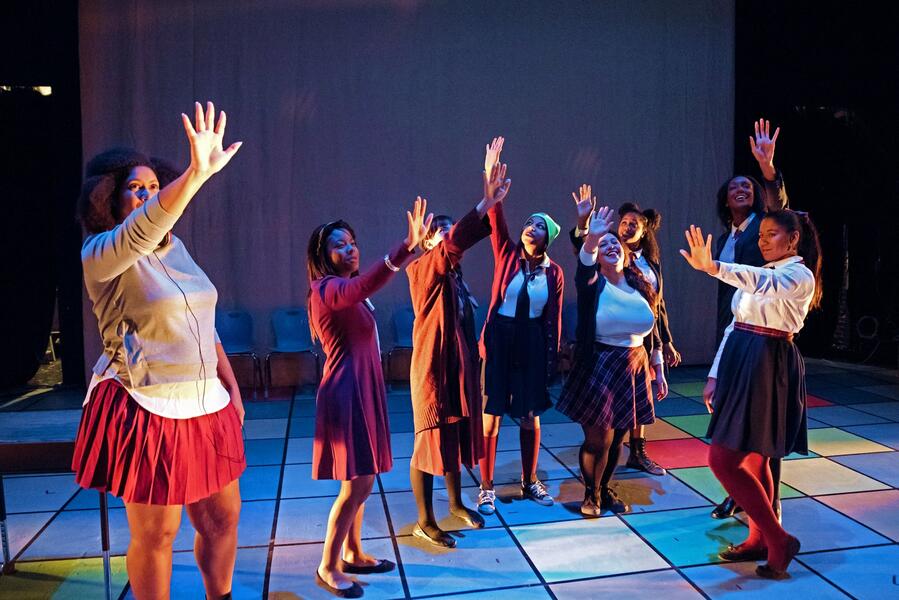 The Goodies OpeningThe opening and closing of the piece were collaboratively written by the cast, creating the idea of an epic, mythological character of "The Teenage Girl."
The Goodies OpeningThe opening and closing of the piece were collaboratively written by the cast, creating the idea of an epic, mythological character of "The Teenage Girl." -
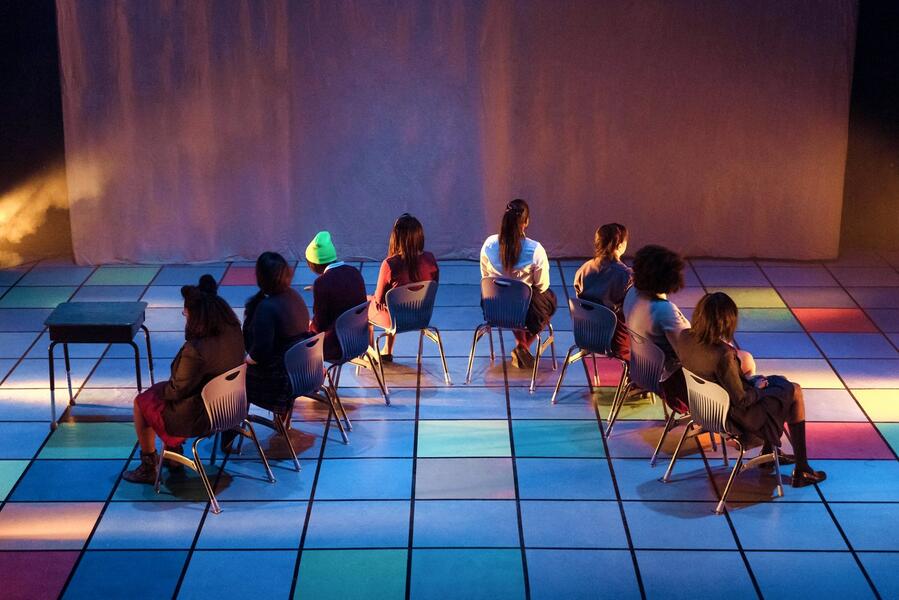 The GoodiesThe set of THE GOODIES was intentionally sparse, using only items found in schools that fluidly moved through different scenes, just like the actors did through different characters. Each actor had a "base" teenage girl that was their primary focus, but they all each played at least one other character if not two, a teacher or administrator at the school. Props and set pieces transformed over the course of the show to elevate the intensity and reality of the narrative into stylistic allegory.
The GoodiesThe set of THE GOODIES was intentionally sparse, using only items found in schools that fluidly moved through different scenes, just like the actors did through different characters. Each actor had a "base" teenage girl that was their primary focus, but they all each played at least one other character if not two, a teacher or administrator at the school. Props and set pieces transformed over the course of the show to elevate the intensity and reality of the narrative into stylistic allegory. -
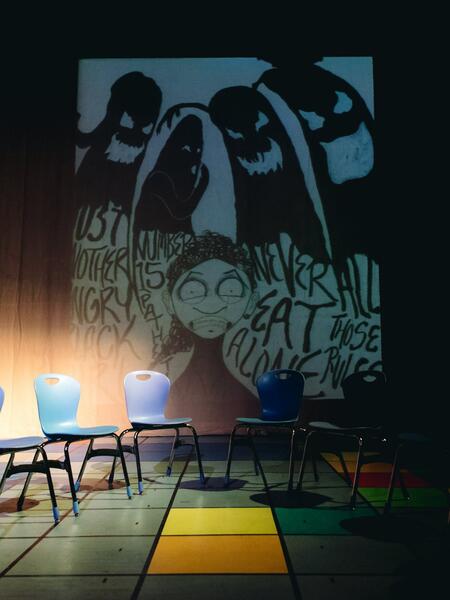 The Goodies ProjectionsIn the devising process, each actor created a nightmare for their character based on the pressures and oppressions they experienced at school. Justin Johnson created illustrations that became the background for those nightmares, which served as the analogy for the "attacks" on the Salem girls in history.
The Goodies ProjectionsIn the devising process, each actor created a nightmare for their character based on the pressures and oppressions they experienced at school. Justin Johnson created illustrations that became the background for those nightmares, which served as the analogy for the "attacks" on the Salem girls in history. -
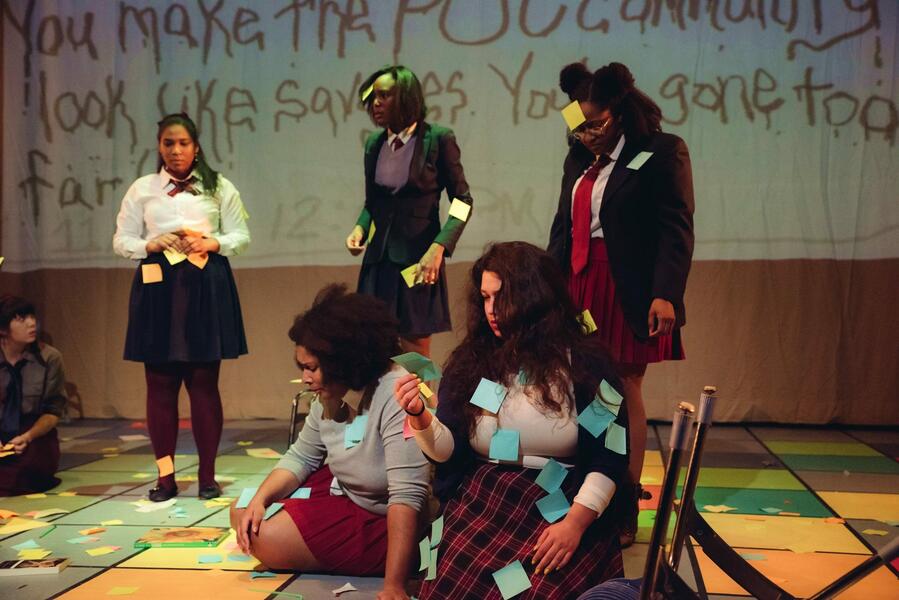 The GoodiesThis is from towards the end of the play, when the world, through Twitter (represented by illustrated projections and sticky notes the actors "posted" to their own bodies), suddenly turns on the girls after previously pushing them to keep naming racists. Social media was a huge driving force of the plot; in the rehearsal process we explored how the internet is the new New World, where we don't quite know what lurks around every dark corner.
The GoodiesThis is from towards the end of the play, when the world, through Twitter (represented by illustrated projections and sticky notes the actors "posted" to their own bodies), suddenly turns on the girls after previously pushing them to keep naming racists. Social media was a huge driving force of the plot; in the rehearsal process we explored how the internet is the new New World, where we don't quite know what lurks around every dark corner.
Co-Director (Performance), Core Deviser: HT Darling's Incredible Musaeum (Submersive Productions)
The piece was challenging on so many levels; for me as a director, with a background of analyzing history through the lens of postmodernism, anti-racism, and feminism, I focused much of my work in this piece on helping the performers create characters and a narrative that told a seemingly familiar story of exploration and conquest in ways that both drew the audience in and knocked them off balance, that required the audience to really question what their modern role in institutional racism and sexism is through encountering characters from the "past" who don't act the way we expect them to. We strove to turn the traditional white male explorer narrative on its head without condemning any of our characters--a practice which Submersive started with Mesmeric Revelations, honed in this piece, and continue to strive for in all our pieces.
HT Darling was also the immersive piece where Submersive solidified our philosophy about "The Essential Audience," in which the role of the audience is never taken for granted in any given moment of the piece, where we never have a "default" role for them, but consider what "character" they are playing in every moment or in the larger whole of the piece, and allow that role to be a foundational ingredient to the entire devising process. In HT Darling, because early on we cast the audience as Invited Patrons of the opening of HT's exhibit, it required an enormous amount of thought about how every scene in the piece was "public," as in there was never a traditional "fourth wall" that provided the characters with privacy. It was tremendously challenging but so artistically rewarding to discover new ways to move the narrative forward in a way that fit in with the structure and dramaturgy of the world, involved the audience, and kept everyone's characters on an organic journey.
HT Darling remains one of my favorite pieces that I have ever worked on. I can claim some individual credit for its success, but it was truly a momumental collaborative process on all accounts.
-
Trailer for H.T. Darling's Incredible MusaeumThis trailer gives a good sense of the movement and characters of the show.
-
 HT Darling RehearsalThis is one of my favorite photos from the rehearsal process of HT Darling. We often found ourselves having the most intense dramaturgical/devising discussions and discoveries in the strangest of places; in this moment, we are in a tiny room on the fourth floor of the Peale, which ended up being a pivotal but very private performance space that only a few audience members ever saw.
HT Darling RehearsalThis is one of my favorite photos from the rehearsal process of HT Darling. We often found ourselves having the most intense dramaturgical/devising discussions and discoveries in the strangest of places; in this moment, we are in a tiny room on the fourth floor of the Peale, which ended up being a pivotal but very private performance space that only a few audience members ever saw. -
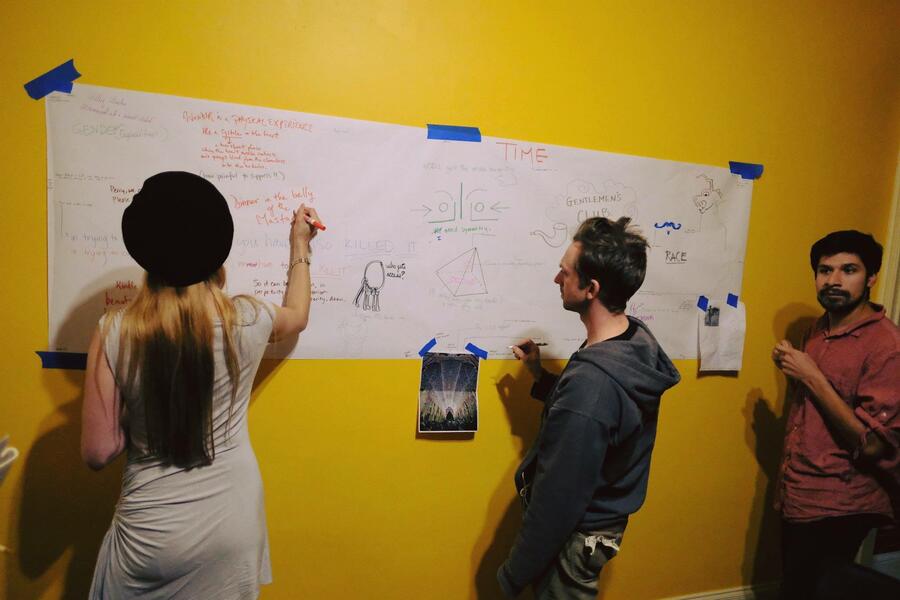 HT Darling 3One of the core parts of Submersive's devising process is group dramaturgy. Here is an early moment in our process with three of our performers adding to the Group Dramaturgy wall. While we also utilize digital tools, we've always found that nothing replaces butcher paper, markers, and tape to start filling in the world of the show.
HT Darling 3One of the core parts of Submersive's devising process is group dramaturgy. Here is an early moment in our process with three of our performers adding to the Group Dramaturgy wall. While we also utilize digital tools, we've always found that nothing replaces butcher paper, markers, and tape to start filling in the world of the show. -
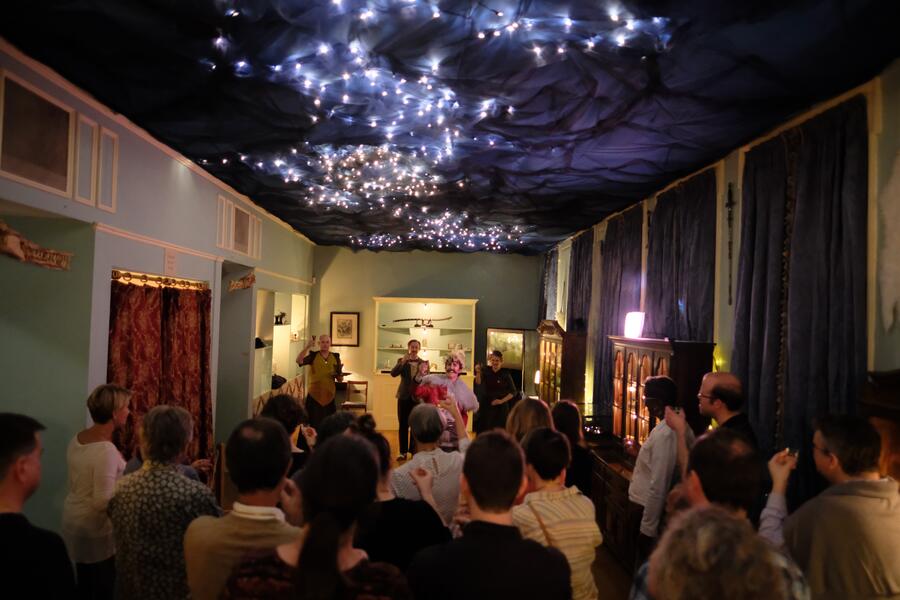 HT Darling Champagne toast.jpgOne the "tentpole" events of HT Darling, the Champagne Toast was deceptively simple in performance but wildly complicated to get just right. Not only with the text, staging, and timing of the performers, but for audience configuration. This was one of of the first moments in Submersive's work where we really needed to "stage" the audience in a specific configuration, because as we discovered in a test run, if we left the audience to arrange themselves, many wouldn't be able to see a pivotal moment in the show, and visuals were really necessary. I still think about the solution to this predicament because it is a great example of why we do collaborative devising rather than following a single person's vision: in our reflection on the test run where we realized that we had to stage the audience, the discussion about how to fix it felt like it was headed to a dead end, until one of our crew members offered out a solution: since we already had the conceit of rules for audience behavior coming directly from HT Darling himself, what if HT Darling gave orders for the audience to arrange themselves in a "cascade formation" with tallest in the back and shortest in the front? The idea was elegant, simple, and best of all, fit into the world and humor of the show. And "Cascade Formation" turned into one of the most beloved moments and phrases in the show. One of the greatest lessons I've learned as a director or even co-director is that I rarely have all the answers, solutions, or fix-its. That listening to everyone on the team and making space for brainstorming is essential to the process, and creating a rehearsal space where everyone feels empowered to share a good idea and make space for others to share is always worth the time it takes.
HT Darling Champagne toast.jpgOne the "tentpole" events of HT Darling, the Champagne Toast was deceptively simple in performance but wildly complicated to get just right. Not only with the text, staging, and timing of the performers, but for audience configuration. This was one of of the first moments in Submersive's work where we really needed to "stage" the audience in a specific configuration, because as we discovered in a test run, if we left the audience to arrange themselves, many wouldn't be able to see a pivotal moment in the show, and visuals were really necessary. I still think about the solution to this predicament because it is a great example of why we do collaborative devising rather than following a single person's vision: in our reflection on the test run where we realized that we had to stage the audience, the discussion about how to fix it felt like it was headed to a dead end, until one of our crew members offered out a solution: since we already had the conceit of rules for audience behavior coming directly from HT Darling himself, what if HT Darling gave orders for the audience to arrange themselves in a "cascade formation" with tallest in the back and shortest in the front? The idea was elegant, simple, and best of all, fit into the world and humor of the show. And "Cascade Formation" turned into one of the most beloved moments and phrases in the show. One of the greatest lessons I've learned as a director or even co-director is that I rarely have all the answers, solutions, or fix-its. That listening to everyone on the team and making space for brainstorming is essential to the process, and creating a rehearsal space where everyone feels empowered to share a good idea and make space for others to share is always worth the time it takes. -
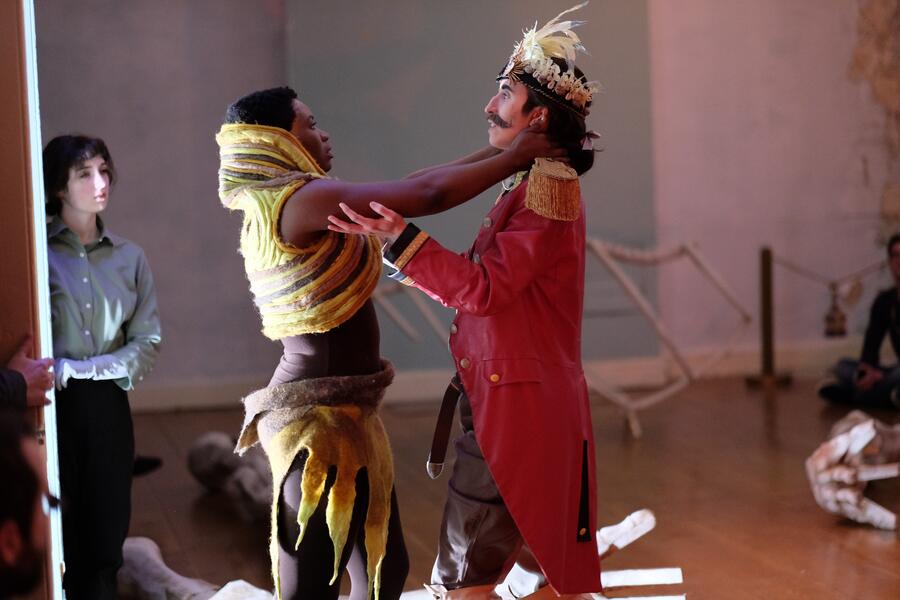 HT Darling--Maxilla HT Exit.jpgThis image captures one Submersive's most foundational missions: to dive into familiar narratives of our culture and society and revision what else could be possible. One of the most delicate aspects of HT Darling was creating a character and a narrative in which HT Darling was both the hero and the critique of the hero trope. What required the most soft touch and careful consideration was the end of HT's story in the show: we didn't want him to end up the hero and yet we also knew that we wanted to deviate from more traditional ways that a tragic hero narrative often ends. What is depicted in this moment was the result of months of conversations, storymaking, careful choreographing, and trial-and-error to have the audience witness HT being given an "out" by Aku Maxilla, the show's true hero, while understanding that he really didn't have a choice--he couldn't stay, because he couldn't be the hero anymore, and it was an act of love for Aku Maxilla to take the burden of him with her. We also undercut HT's hero status by not having the show end there: after a huge climactic scene on the third floor, the other four characters' narratives fully played out, with the "real" end of the story happening in a much smaller, more intimate, quieter way in the back of the first floor.
HT Darling--Maxilla HT Exit.jpgThis image captures one Submersive's most foundational missions: to dive into familiar narratives of our culture and society and revision what else could be possible. One of the most delicate aspects of HT Darling was creating a character and a narrative in which HT Darling was both the hero and the critique of the hero trope. What required the most soft touch and careful consideration was the end of HT's story in the show: we didn't want him to end up the hero and yet we also knew that we wanted to deviate from more traditional ways that a tragic hero narrative often ends. What is depicted in this moment was the result of months of conversations, storymaking, careful choreographing, and trial-and-error to have the audience witness HT being given an "out" by Aku Maxilla, the show's true hero, while understanding that he really didn't have a choice--he couldn't stay, because he couldn't be the hero anymore, and it was an act of love for Aku Maxilla to take the burden of him with her. We also undercut HT's hero status by not having the show end there: after a huge climactic scene on the third floor, the other four characters' narratives fully played out, with the "real" end of the story happening in a much smaller, more intimate, quieter way in the back of the first floor.
Co-Director, Core Deviser: Mesmeric Revelations! of Edgar Allan Poe (Submersive Productions)
I was hired by Glenn Ricci, whom I did not know at that point, to be his co-director for Mesmeric Revelations. Because he was relatively new to the theater scene in Baltimore, I helped him cast the piece, and brought my skills in theater to compliment his skills in audience interaction and sound design. For much of my career, I have been interested in how performers interact with architecture and the audience, and Mesmeric Revelations was the first time I got to practice this on such a large scale, even though the piece was fairly intimate.
The biggest challenge of this piece was de-centering Edgar Allan Poe from his own narrative, since we were focusing on the women, both fictional and real, in his life. Finding their humanity through the many layers of romanticism and nostalgia we have placed on them was an amazing dramaturgical and performative challenge, and this piece remains one of the biggest learning processes I've ever had in that realm.
-
The Mesmeric Revelations! of Edgar Allan Poe - The Immersive Theater Experience Returns Fall 2015This is the trailer for the second run of Mesmeric Revelations after our first sold-our run in the spring of 2015. Unlike most theatrical performances, we had to film it with no outside audience, using six volunteer audience members who had a small camera strapped to their chest, and following one character around the entire time. This trailer gives a sense of the multiple layers of movement, narrative, character, and design that were woven through every inch of this performance.
-
Mesmeric Revelations 1.JPGA still from the seance scene in Mesmeric Revelations. One way we created a full-length show as an ensemble was to have "tentpole" scenes like this one, which created moments for the disparate characters to come together and for larger audience interactions, in addition to being a landmark as we devised six full-length plots for every character. The hard work of this scene was not only timing, but trial-and-error of how to get the audience to interact, as well as how to have several characters' plotlines converge at simultaneously critical moments without pulling too much focus from the seance itself.
-
Mesmeric Revelations 2.JPGThe "Chess Match" scene, relatively early in the show, in which Auguste and V, a mysterious late-comer, squared off over a chess match in which the stakes were literally raised higher and higher. This scene is another great example of the interweaving layers of story and design that go into every detail of immersive work: this scene required as much physical choreography as it did careful curation of text/dialogue as a way to clue the audience in about who both Auguste and V were, as well as activating the environment and furniture in unexpected ways. It took us quite a bit of time to find two identical tables that were both period-specific and sturdy enough to hold two actors doing intense physical work on top of them night after night.
-
Mesmeric Process 1.JPGThis is me bringing my contributions to the "group dramaturgy" wall we created during our initial character development process. One of the most joyous parts of devising with Submersive is the initial development process, when the whole team has come together and we all bring various forms of inspiration and research to the table to throw into the big devising stewpot. Even when the concept for a show comes from one person, once we start our process, everyone is contributing. We've always found that listening to what everyone brings to the table creates a much deeper and richer show than having a singular vision.
-
 Mesmeric Process 2.jpgThis is a photo of me addressing the cast of Mesmeric Revelations (remount). I'm always incredibly grateful to have developed as a directing by doing devised immersive work; it's very different than traditional proscenium shows, not only the needs of performers, management, and designers, but also in how important cultivating trust among the whole team is early in and throughout the process. At some point, there would be parts of the show I'd simply never see again, so learning to let go of an immense amount of control and trust the actors, as well as helping the actors and crew trust each other to perform with and stay safe with audience when the show is running is equally as important as the performance and plot. Additionally, learning to "play" the audience becomes a huge part of directing immersive pieces, as well as giving the kind of feedback that helps actors be self-generative, rather than only relying on the director to give them ideas. Not all actors are trained that way or are used to it, and so giving them space and time to learn, experiment, and grow is also part of our process.
Mesmeric Process 2.jpgThis is a photo of me addressing the cast of Mesmeric Revelations (remount). I'm always incredibly grateful to have developed as a directing by doing devised immersive work; it's very different than traditional proscenium shows, not only the needs of performers, management, and designers, but also in how important cultivating trust among the whole team is early in and throughout the process. At some point, there would be parts of the show I'd simply never see again, so learning to let go of an immense amount of control and trust the actors, as well as helping the actors and crew trust each other to perform with and stay safe with audience when the show is running is equally as important as the performance and plot. Additionally, learning to "play" the audience becomes a huge part of directing immersive pieces, as well as giving the kind of feedback that helps actors be self-generative, rather than only relying on the director to give them ideas. Not all actors are trained that way or are used to it, and so giving them space and time to learn, experiment, and grow is also part of our process.

